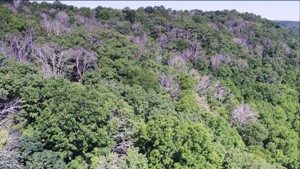| FAQs
What is an emerald ash borer?
The emerald ash borer is an exotic beetle, originally from Asia, that was first discovered in Michigan in 2002 and in Indiana in 2004. This invasive insect is 1/3 inch in length and bright, metallic green in color. The adult lays eggs only in ash trees. Emerald ash borers in the U.S. have no predators during their larval stage.
How do they kill ash trees?
Larvae feed on the inner bark of the tree, creating tunnels that circle the trunk and cut off the flow of water and nutrients from roots to leaves. Leaves in the top third of the tree die first, and then the damage moves down to lower branches.
Why should we care?
Ash trees make up 10-20% of the diversity of tree species in our Hoosier forests, totaling about 147 million trees. Another two million grace city parks, residential lawns and street plantings. Ash wood is used for furniture, flooring, cabinets, hockey and lacrosse sticks, baseball bats, urban street plantings, and Native American traditional baskets, pipe stems, flutes and medicinal remedies.
To maintain a remnant population of ash trees in Indiana, we must save mature, seed-producing specimens to create a future seed source of EAB-resistant ash trees. These trees are native species to our Indiana forests and the introduction of EAB is a man-made disaster, not a natural one. It is up to us to preserve these native species so they may repopulate after the killing wave of EAB has passed.
The chestnut blight of the late 19th century and the Dutch elm disease in the mid-20th century virtually eliminated those two species from our woodlands and streetscapes. We have the opportunity to keep that from happening again with our native ashes.
What’s the treatment?
A special insecticide is injected into holes drilled near ground level and kills emerald ash borers as it’s drawn upward. The insecticide used in this program (Emamectin benzoate) is safe for pollinators like honey bees (not a neonicotinoid). IPA’s Save our Ash Trees! program focuses on areas of the state that have not already been decimated by the emerald ash borer.
How bad is the problem?
Millions of mature ash trees have already been killed in Indiana, and the mortality rate is expected to hit 95% in the next decade. Projected economic losses to urban forests are estimated to be $10-20 billion. The U.S. Forest Service projects that all eight billion ash trees in American forests will die off unless protected against the emerald ash borer. |




